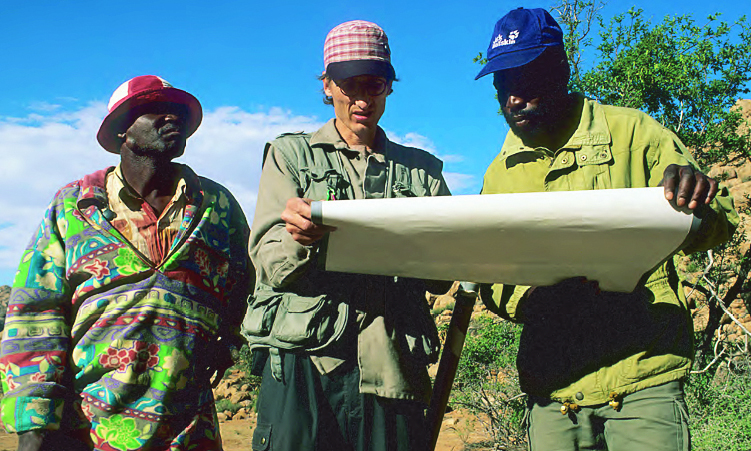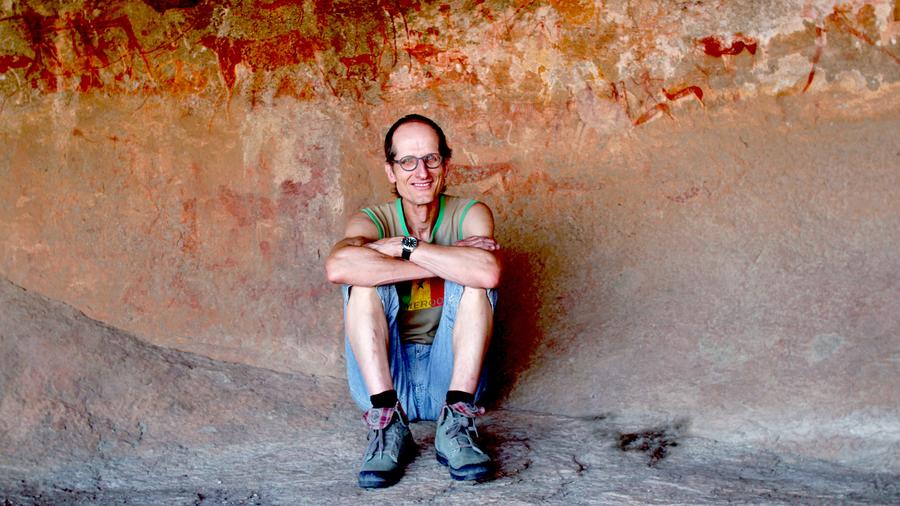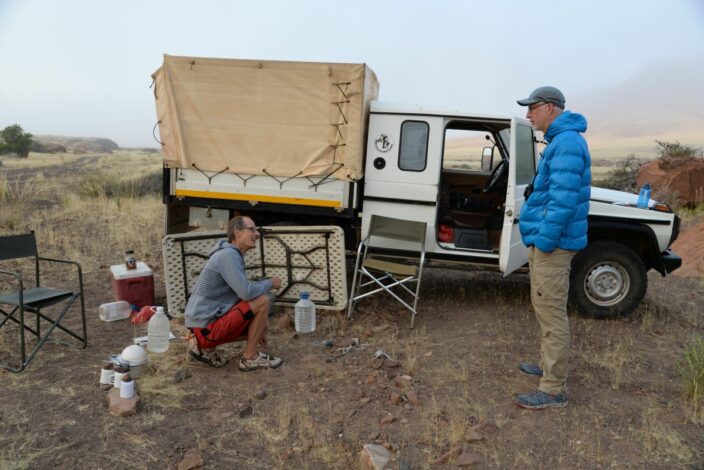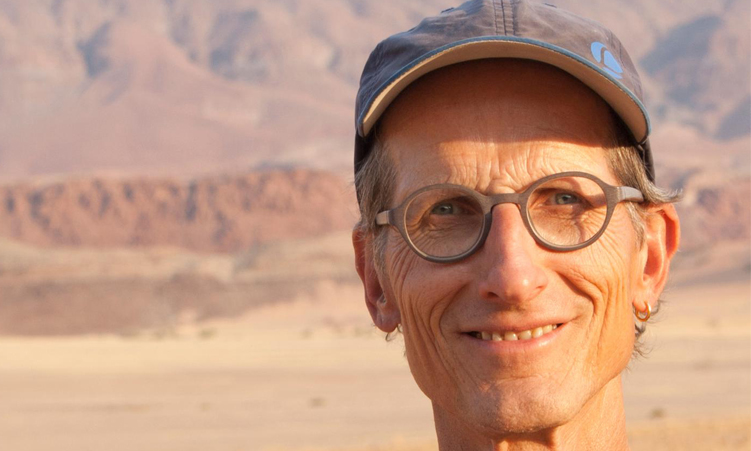On 1 November 2023, as we clicked on an attachment in a mail, we knew it would be devastating news.
Dr Honey Badger gave us regular updates on Tilman Lenssen-Erz’ cancer treatment over the last two years, but it sadly took his life on 10 November last year in Cologne, Germany.
Lenssen-Erz was the head of the African Archaeology Archive Cologne – a large-scale digitising project on the prehistory and history of the environment of north-eastern and south-western Africa.
He was also the head of rock art research and a research associate of African archaeology at the University of Cologne. He was equally a member of the Heinrich-Barth-Institute in cooperation with the University of Cologne, the co-director of Tracking in Caves, the co-director of Indigenous Knowledge and Archaeoinformatics, and the co-director of Modellierung Prähistorischen Jagdverhaltens.
Lenssen-Erz was also the director of the Brandberg/Daureb database.
He was so much to many: a dear friend, a family man, a colleague, a mentor, an intellectual, an exceptionally talented researcher and one of the pioneers and leading international archaeologists who dedicated his professional service to Namibia’s archaeological heritage and museum sector.

HARD AT WORK … Tilman Lenssen-Erz working with Angula Shipahu and Efraim Matteus in the Brandberg Mountain. Photo: Marie-Therez Erz
Yes, his scientific work and resumé in general are insanely impressive in Namibia, but we believe he’ll be remembered more for the qualities that define who he was as an honest human being.
Lenssen-Erz has worked as an archaeologist since 1989, and has led various archaeological excavations, supervised sites, and conducted research on various excavations in Germany, Tunisia, Egypt and Namibia.
He received his doctorate in prehistory on Brandberg rock art at the University of Frankfurt in 1997.
Prior to that he obtained his master’s degree in African studies, prehistory, phonetics and history of religion at the University of Marburg.
Lenssen-Erz had a broad background in the archeology of Namibia, Germany, Tunisia and Egypt – from prehistory to the late stone period.
His special fields of interest included the ecology of rock art, landscape archaeology, textual archaeology, gender and rock art, aesthetics in rock art and digital archiving.
‘BRILLIANT, HUMBLE’
Lenssen-Erz was a brilliant man.
However, when brilliance is packaged in a human being along with humility, kindness, generosity, resilience and a wicked sense of humour, you really have someone special.
TilmanLenssen’s successful career gave him the platform to share his exemplary character with many people, particularly prehistoric rock art researchers across the globe, many local communities and, in particular, descendants of hunter-gatherers in Botswana, Namibia and Australia.
He exchanged many friendships with different people across cultures, inspired and engaged generations of archaeology university students, informed and educated countless readers of his publications over decades and had professional colleagues throughout his life.
In Namibia, he took a different research approach, working solely and directly with Namibia’s museums and heritage institutions, the archives, and involved the University of Namibia (Unam) under various archaeology research projects funded by the German Research Foundation over the last three decades.
He was particularly fond of working with and directly involving local communities in his research projects.
He did everything from archaeological field-based rock art surveys to archaeological excavations, interpretations, and analysis, and used artificial intelligence tracks in caves with descendants of hunter-gatherers.
Tate Angula Shipahu and Ephraim Matteus from Uis, who initially intensely worked with Harald Pager from 1977 until his death in 1985 on the Brandberg mountain and later with Lenssen-Erz, will tell you who he was.
Furthermore, Ui Kxunta, Thui Thao, and Tsamkxao Ciqae, the Ju/’hansi indigenous hunters and trackers from Nyae Nyae Conservancy at Tsumkwe, who worked with Lenssen-Erz and his team from 2013 to date, must be deeply saddened by his passing.

‘MENTOR AND FRIEND’
I met Lenssen-Erz and his wife, Marie-Therez Erz, in Windhoek in 2006, when I was an undergraduate student at Unam.
They took me under their mentorship programme to Botswana while preparing the archaeology training seminar for local community guides and researchers at Tsodilo world heritage site.
From thereon, Lenssen-Erz became a mentor, a wonderful friend, and a colleague until his passing.
His passing has left a void which could never be filled.
We hope that Marie-Therez, their daughters, their grandchildren and the rest of his family will find strength and support in knowing that Lenssen-Erz will live on in the memories of the many, many people he has known and influenced.
To take just a few of many prominent examples from throughout his career in Namibia, Lenssen-Erz’s immense contribution, innovative and enduring research have made a significant impact on the discipline, archaeological heritage landscape and museum sector.
The monograms he was involved in are still the world’s largest series ever produced at an archaeological site.
This was followed by his conceptualisation and realisation of the permanent exhibition called ‘Rock Art in Namibia’ at the National Museum of Namibia in 1998, comprising around 43 000 individual rock painting figures.
In 2009, Lenssen-Erz secured funding from the Jutta Vogel Stiftung towards rock art survey management in Dome Gorge, upper Brandberg, which oversaw the documentation of a unique site containing paintings and engravings on the same geology.
Perhaps the biggest project that has benefited Namibia to date is the funding from the DFG in 2012 for the development of the African Archaeology Archive in Cologne.
On this database, Namibia’s inventory stands at 19 055 archaeological sites documented.

And more recently, from 2013 to date, Lenssen-Erz has also secured funding from the DFG for the ‘Tracking in Caves’ project.
The project combines archaeology with indigenous knowledge to obtain an in-depth analysis of prehistoric human tracks, mainly in the ice age caves of France. Here, three San-Namibian indigenous trackers from the Ju/’hansi community at Tsumkwe travelled to France to work along with Andreas Pastoors and Lenssen-Erz to investigate human tracks in France.
This collaborative project culminated in a documentary of the San men’s work alongside the archaeologists, which was presented at a number of conferences in Namibia, Germany and France.
Lenssen-Erz was a brilliant researcher. He shared so much of himself with all those who were privileged to know him well.
He adored his family and was inseparable from his beloved Marie-Therez.
He always spoke so tenderly and proudly of his children and his grandchildren. Lenssen-Erz will be sorely missed by all who knew him.
We extend our sincere condolences to Marie-Therez, their children and grandchildren.
*Alma Nankela is the head of RCHS at Archaeosciences and Consultants.
Stay informed with The Namibian – your source for credible journalism. Get in-depth reporting and opinions for
only N$85 a month. Invest in journalism, invest in democracy –
Subscribe Now!






